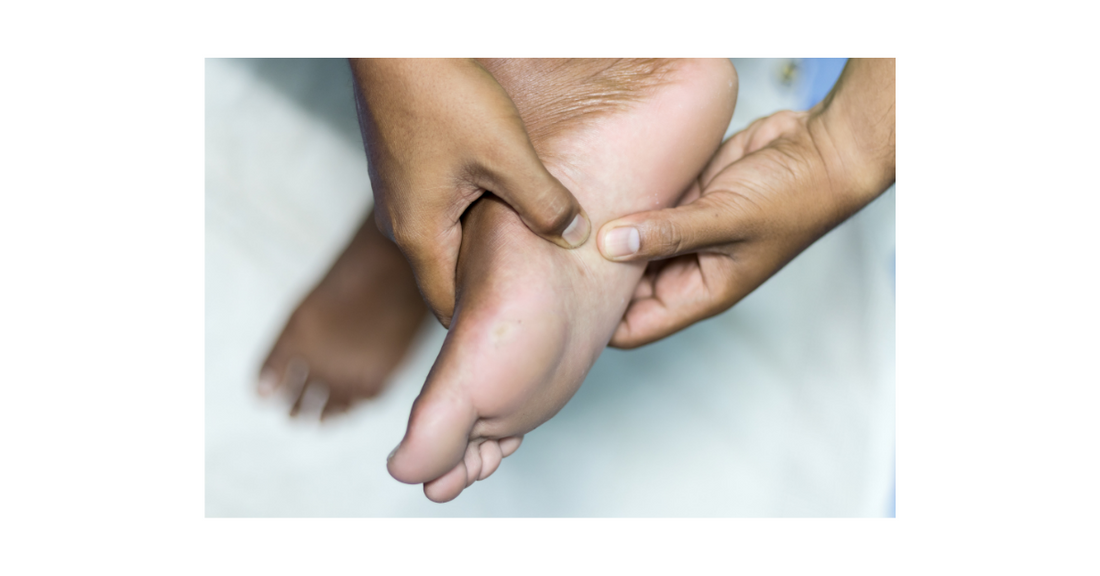
How is Ledderhose Disease Similar to Dupuytren’s?
Although originally designed for patients with Dupuytren’s Contracture, our Dupuytren's cream has been shown to be effective for those with Ledderhose Disease. We have also recently found that it helps people manage pain and inflammation associated with Trigger Finger.
Symptoms
Ledderhose disease, also known as plantar fibromatosis, is very similar to Dupuytren’s contracture but affects the feet instead of the hands. Ledderhose causes a build-up of connective tissue and creates hard lumps on the bottoms of the feet. These lumps form along the plantar fascia, which is the band of tissue that connects your heel bone to your toes. The growths aren’t cancerous, but they can cause pain, especially when you walk or are engaged in strenuous activity.
Occurrence
Ledderhose disease can occur alongside Dupuytren’s contracture or on its own. Like symptoms of Dupuytren’s, symptoms of this condition normally begin to appear when someone is in their forties or fifties. The primary symptom of Ledderhose disease is hard lumps on the soles of one or both of the feet. These lumps can be painful, especially when you walk, and they can also cause referred pain farther up the foot and in the ankle joints.
Cause
There are many similarities between Dupuytren’s and Ledderhose disease. Another commonality is that the exact cause of Ledderhose disease is still unknown. Again, as with Dupuytren's, researchers believe genetics and age are both major contributing factors. People who are living with Dupuytren’s or other connective tissue diseases are also much more likely to have Ledderhose disease.
Treatment
Another intersecting point between the two conditions is treatment, since options are limited and not always effective with a high chance of relapse. In the early stages, mild issues may be present with little to no discomfort. As the lumps continue to grow, people may benefit from soft shoe inserts to alleviate the pressure on the lumps when they walk. It is also recommended to cut holes in the inserts that align with the lumps and provide additional space, so you get some added relief while walking. Gentle stretches, massage, and ice to the sole of the foot can also be very helpful for pain relief. You can also try nonsteroidal anti-inflammatory drugs (NSAIDs) such as ibuprofen or naproxen to reduce pain and swelling as needed.
Other options for treating the symptoms of Ledderhose disease include physical therapy, stretching exercises, and massage of the feet. Depending on the therapist and their school of thought, you may be recommended to wear splints on the feet, but most patients find these highly impractical since they make walking more difficult and are only ideal for times when they are at rest.
Steroid injections are recommended by some physicians to relieve pain and reduce inflammation. In extreme situations where the lumps are very painful, your doctor might recommend a type of surgery called a fasciectomy. During this procedure, the surgeon will remove part or all of the thickened tissue from your foot. The surgery can leave scars and Ledderhose disease can eventually come back (potentially worse than it was before). Cryotherapy is also another potential treatment option that involves freezing the lumps and killing the tissue to make the bottom of the foot appear as it should. This is minimally-invasive but it can be costly and there are mixed reviews on its effectiveness.
Other Options
Some promising new options, such as topical creams, are now recommended for Dupuytren’s contracture and they can also be effective in combatting the symptoms of Ledderhose disease. Our contracture cream is ideal for Dupuytren's, since it uses all-natural ingredients, helps fight inflammation, and has been reported to slow or entirely stop the progression of symptoms for both Dupuytren’s contracture and Ledderhose Disease.
Learn More